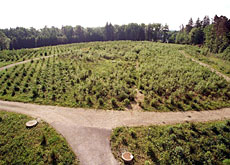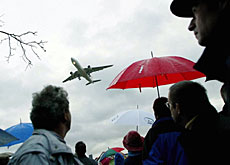Constant surveillance guarantees fresh air

Many people in Switzerland take clean and healthy air for granted – thanks largely to a monitoring system set up 25 years ago.
Known by its German acronym Nabel, the national air pollution-monitoring network consists of measuring stations around the country.
In order to be as representative as possible, the 16 stations are deliberately sited in a wide range of locations from city centres to rural areas and even on the top of a mountain.
Here, sensitive instruments monitor substances such as nitrogen dioxide, sulphur dioxide, ozone, fine dust particles and heavy metals such as lead and cadmium.
“In Switzerland, we monitor pollutants which are emitted in large quantities and which are harmful to human health and the environment,” said Urs Nyffeler at the air pollution control division of the Swiss Environment Agency.
From this data, researchers are able to build up a national picture, which affects decision-making in Switzerland, Europe and beyond.
Threat to health
In the 1950s rapid industrial growth and a heavy increase in road traffic led to a sharp rise in the emission of air pollutants.
Even at low concentrations some of these can be toxic, affecting the respiratory tract and other organs.
“Studies in Switzerland have shown that the lung function of adults is lower in areas with higher air pollution and there are more symptoms, more chronic bronchitis,” said Regula Rapp, a scientist the Institute of Social and Preventive Medicine in Basel.
Nabel data is invaluable for long-term health studies, she added.
“We have to look at the health outcomes over many years so it’s important that we have reliable, continuous measurements.”
“It’s not short smog episodes but the long-term impact on health which is very important.”
Early warning
Nabel serves as both a monitoring network and an early warning system. It also shows whether the methods to reduce air pollution are successful.
“If you look over the last 10-15 years, then you see a marked decline in all the harmful substances,” Nyffeler told swissinfo.
The amount of lead has dropped by 90 per cent, nitrogen dioxide by half and fine dust by a third. Even the quantity of ozone has declined.
“That doesn’t mean we can rest on our laurels,” he added. “There’s still far too much nitrogen getting into the ecosystem and that’s not just in Switzerland but Europe and elsewhere.”
Emissions of nitrogen compounds from agricultural sources affect air quality and can have serious effects on ecosystems.
The most significant of these are ammonia, primarily from fertilizers and livestock, and nitrogen oxides from fuel combustion in farm equipment.
To comply with the 1999 Gothenburg Protocol, which calls for a cut in ammonia emissions by 2010, Switzerland will introduce continuous ammonia monitoring by the middle of the year.
“There is a lot of interest in decreasing ammonia emissions,” said Christoph Hüglin, who runs Nabel’s operations. “With monitoring, we can then see if the measures are successful.”
Diesel fumes
Ozone also remains a problem as do soot particles from diesel fumes
Hüglin said that studying the trend of elemental carbon deposited as soot particles was one of the priorities in coming years.
Although fine dust particles with an aerodynamic diameter less than 10 micrometres – known as PM10 – are already monitored, there are growing concerns about even finer particle fractions.
“The big issue is to reduce the fine particles which go deep in the lung,” said Richard Ballaman, senior adviser in the air pollution control division of the Swiss Environment Agency.
“That’s a real problem for human health and that has to be solved.”
Metal fatigue
Acids such as nitrogen dioxide and sulphur dioxide, which are transported by rain or attached to dust particles, can damage building and monuments.
At the Federal Laboratories for Materials Testing and Research in Dübendorf, researchers examine the effects of air pollutants on metals such as zinc and copper.
Their counterparts in the United States focus on the effects on glass and stone.
Collecting data is, of course, just one step in the wider picture.
“We are speaking about a monitoring network,” said Ballaman. “But it is clear that it’s most important to reduce pollutants and to have effective abatement measurements.”
swissinfo, Vincent Landon
The national air pollution monitoring network (Nabel) was established in 1978.
The 16 stations that form the network are located throughout Switzerland.
The stations are operated by the Federal Laboratories for Materials Testing and Research under the supervision of the Swiss Environment Agency.
Air pollution monitoring stations operated by cantons and cities complement Nabel.

In compliance with the JTI standards
More: SWI swissinfo.ch certified by the Journalism Trust Initiative











You can find an overview of ongoing debates with our journalists here . Please join us!
If you want to start a conversation about a topic raised in this article or want to report factual errors, email us at english@swissinfo.ch.